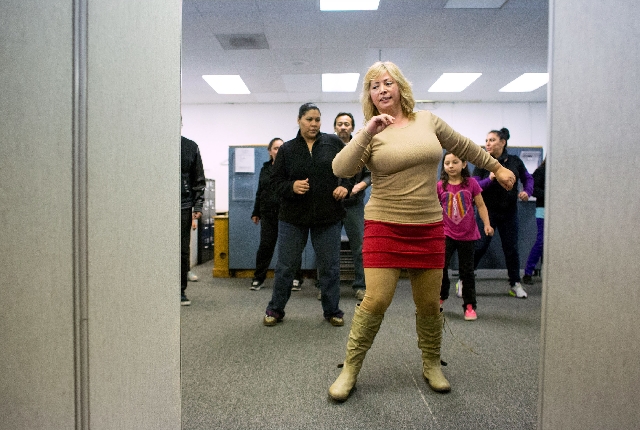Muevete Bailando class helps Latinos get active, fight diabetes

When a working single mother of three prepares dinner, it can come with plastic toys in a paper bag more days out of the week than she’d like to admit.
That’s part of the reason Martha Sotelo, 39, has come to the Nevada Alliance Against Diabetes this Thursday night. The other part started taking its toll when she moved to the United States from Sinaloa, Mexico, in 1992. That’s when, she says, her life, health and body changed.
“In Mexico, I used the bus or a bike or just walked,” she says. “Here, it’s drive everywhere, anywhere.”
She’s one of 16 people taking part in the bimonthly Muevete Bailando, or Moving Dancing, a partnership with the Southern Nevada Health District that focuses on diabetes education and fitness, targeting local Latinos. After 30 minutes of education, the group takes a dance class. Between the two, they learn the importance of diet and exercise.
Sotelo doesn’t have diabetes, but as a Latina, she knows her chances for getting it are double that of white people. She’s here as a preventive measure.
According to the Office of Minority Health, 13.2 percent of Latinos have diabetes. The numbers don’t lie, but Olga Martin, nutritionist and diabetes educator for the Nevada Alliance Against Diabetes, says Latinos have been misinformed.
“Unfortunately, they have been told it’s a genetic predisposition,” she says. “But it’s not. It’s about habits.”
It usually starts the same way Sotelo’s weight gain and poor diet did, through an abrupt lifestyle and culture change.
When immigrating to this country, Latinos stop walking everywhere. Especially in Las Vegas, where it’s frequently very hot or cold, even parking spots become a hunt for the shortest walk to the entrance.
Also, foreign-born Latinos come here and discover North American supermarket prices, which leads to the world of fast food. If it’s not eating out, it’s purchasing highly processed foods from the grocery store to save money. It all adds up to a diabetes countdown.
Today’s Muevete Bailando class is smaller than past groups. It just moved to its new location at Nevada Alliance Against Diabetes from a dance studio at Boulevard Mall. The educational part is usually 30 minutes long, but a crop of new faces today has so many questions, it extends to nearly an hour.
The nutritionists received the most moans and groans after telling participants, in Spanish, that tortillas aren’t conducive to diabetes prevention. A lot of what they’re regularly eating isn’t.
When the diet overhaul isn’t quite getting through, Martin has an example she likes to use with clients: “To make it simple, I say, ‘Imagine you live on a farm in Mexico on a high hill away from any stores. You eat only what the land produces.’ ”
That usually crystallizes the point. Two major nutrition deficiencies predominant in the Latino community are magnesium and vitamin D. The former is caused by a lack of green vegetables, the latter by a lack of sun (many immigrants who don’t work outside work in factories).
Once tonight’s class understands most of them need to go home and clear out the cupboards, the group moves to another room. With cubicles around them and fluorescent office lighting above them, they form two lines. Ixela Gutierrez, a blond woman in leggings, faces them.
The bass starts up and a reggaeton beat kicks in. Gutierrez leads the group in warm-up moves, turning her head from side to side and then shifting her weight from left leg to right leg.
Gutierrez, a professional dance instructor, used to skip the educational part of the class and just show up to lead the fun part. Then she was diagnosed with diabetes. Before today’s dance class, she had the most questions for the nutritionists.
After she has the class warmed up, she starts dancing a cumbia. There are four men, five women and seven kids following her. Some of them look well-versed in the popular Latin dance, others need practice. All of them, however, are laughing, clapping and dancing.
Most importantly, they’re exercising.
“You know what they say? (Latinos) are born dancing,” Gutierrez says. “It’s a great element we’re missing. The idea is to not stay home, but with telenovelas, computers, Facebook, we’re not getting out like we used to.”
When the music finally stops, Gutierrez’s bangs are damp with sweat. Students are breathing heavy. All of them but one came to find out how to prevent diabetes.
Jose Borgez, 57, is the sole diabetic of the group. He’s glad he came after seeing a commercial on Galavision because he learned a lot in the two hours.
“I need to eat more fruits and veggies,” he says. “And I need to eat more meals in the day.”
The former truck driver made a habit of eating fast food during his short stops and never broke out of it. Today he learned to break up meals with small healthful snacks and to start walking to close destinations instead of driving. He also learned to cumbia.
Contact Xazmin Garza at xgarza@reviewjournal.com or 702-383-0477. Follow her on Twitter @startswithanx.